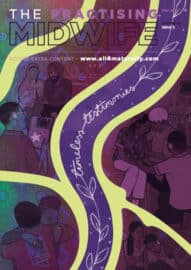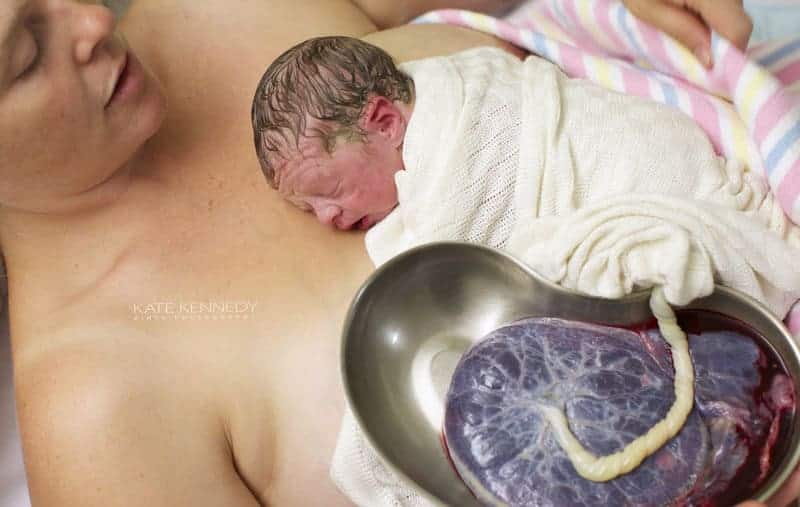Nature’s first stem cell transfer occurs at birth
Hannah Tizard – Midwife and Founder of the Optimal Cord Clamping #BloodtoBaby Campaign
Amanda Burleigh – Midwifery Consultant and Optimal Cord Clamping Campaigner
This month I am writing with a wonderful colleague and friend Amanda Burleigh who is a long standing campaigner of optimal cord clamping (OCC). Amanda and I regularly collaborate to highlight the requirement for all babies to receive their full blood benefit by not intervening by immediately clamping the umbilical cord at birth.
Today we discuss the topic of umbilical cord blood banking (UCB) which is known to be a contentious issue within the midwifery and obstetric world. Parents here in the UK and across the globe are beginning to show interest in preserving their baby’s stem cells through the practice of UCB. Our concern is that this practice sometimes does not allow for adequate newborn blood transition, facilitated through delayed (DCC) or optimal cord clamping (OCC) and deprives their baby of their own blood at birth. Parents may not be fully aware of the risks of immediate cord clamping (ICC). It is our view that parents need all the information available in order to be part of the decision making about what is best for their baby at birth.
There are many varied and complex factors at play here. In this blog we introduce these complexities and some of the issues. We then go on to propose solutions to some of the problems. We want to be clear that we take a holistic view of all factors, we support midwifery principals, newborn physiology and individualised care – each woman, family and child are distinctive and special. They have a right to informed choice and require careful and compassionate support with regard to the evidence for DCC/OCC and UCB.
Professional backgrounds
Amanda regularly travels the country and abroad giving presentations about OCC and co-facilitates the #waitforwhite campaign page on Facebook. Amanda along with consultant obstetricians, neonatologists and paediatricians co-developed the Basics Lifestart trolley which enables intact cord resuscitation (Weeks et al., 2014).
Amanda introduced me to Twitter about 4 years ago when I produced the first OCC stickers, which rapidly became the ‘must have’ item for women planning birth. Since then I have worked hard to develop the #BloodtoBaby campaign. I continue to run www.bloodtobaby.com, facilitating distribution of OCC resources and awareness of new perspectives such as resuscitation with the cord intact.
Continued challenges to optimal cord clamping
Midwives, doctors, birth workers and activists have worked hard for over a decade to advocate for the newborn baby, who can be deprived of up to 30% of its blood through ICC (Mercer, 2010). Farrer et al., (2010) suggest placental transfusion allows for an additional mean volume of 83mls of blood at birth. ICC became routine practice at most births around 40-50 years ago when in retrospect there was no evidence to support this practice. The evidence for DCC and OCC is significant, you can find a list of some here!
 Through campaigns to raise awareness and share evidence we’ve joined others to influence policy makers and central institutes who guide maternity care across the UK and the world. NICE guidance now recommends DCC of 1-5 minutes and more at maternal request (2014) and WHO (2012) suggest DCC (not earlier than 1 min after birth) is recommended for improved maternal and infant health and nutrition outcomes. However many maternity services consider a standard 1 minute to be DCC and their guidelines reflect this. In some hospitals standard practice without additional request from parents is an obligatory one minute. With continued pressures on NHS maternity services, parents are not always offered sufficient information and time to discuss the benefits of DCC/OCC. Many are not involved in the decision-making around the intervention of cutting and clamping the cord.
Through campaigns to raise awareness and share evidence we’ve joined others to influence policy makers and central institutes who guide maternity care across the UK and the world. NICE guidance now recommends DCC of 1-5 minutes and more at maternal request (2014) and WHO (2012) suggest DCC (not earlier than 1 min after birth) is recommended for improved maternal and infant health and nutrition outcomes. However many maternity services consider a standard 1 minute to be DCC and their guidelines reflect this. In some hospitals standard practice without additional request from parents is an obligatory one minute. With continued pressures on NHS maternity services, parents are not always offered sufficient information and time to discuss the benefits of DCC/OCC. Many are not involved in the decision-making around the intervention of cutting and clamping the cord.
In addition to time factors and lack of understanding, there appears to be some resistance resulting in slow progress to change practice of ICC in line with evidence (Gams et al., 2017). And, there has also been the introduction of the profitable practice of both public and private UCB.
Umbilical cord blood banking
 The newborn’s blood which runs through the umbilical cord to the placenta, also known as ‘cord blood’ – full of stem cells, can, once a baby is born, be collected and used to treat blood disorders, for regenerative cell therapy and immune modulation. Since the first successful treatment in 1988, a plethora of UCB companies have appeared with the aim to harvest this blood (Stanevsky, Goldstein and Nagler, 2009). Today the potential for use of ‘cord blood’ is increasing exponentially as more and more evidence highlights that this reservoir of cells has regenerative potential for many clinical applications (Roura et al., 2015).
The newborn’s blood which runs through the umbilical cord to the placenta, also known as ‘cord blood’ – full of stem cells, can, once a baby is born, be collected and used to treat blood disorders, for regenerative cell therapy and immune modulation. Since the first successful treatment in 1988, a plethora of UCB companies have appeared with the aim to harvest this blood (Stanevsky, Goldstein and Nagler, 2009). Today the potential for use of ‘cord blood’ is increasing exponentially as more and more evidence highlights that this reservoir of cells has regenerative potential for many clinical applications (Roura et al., 2015).
Indeed it could be said that the increasing understanding of the potential of these stem cells has helped reinvigorate the importance for the newborn to receive DCC or OCC (Brown, 2012). Borlongan et al. (2015) state that even a delay of just 180 seconds increases newborn blood volume by 75mls which could equate to up to 45,000 haematopoietic stem cells.
One of the main issues about UCB is around the quantity of blood taken, because most UCB companies prefer larger volume retrieval of cord blood, which equates to more stem cells. This compromises the effort made by birth workers to ensure the newborn receives DCC/OCC!
Tensions
There are real tensions between these two practices. It’s true, we can’t ignore the potential for using stem cells, and there will be many children and families desperately requiring these samples to treat illness like leukaemia (Brunstein, Setubal and Wagner, 2007) and cerebral palsy (McDonald et al., 2017). Clinical trials are currently examining use of stem cells for the treatment of a huge range age related conditions such as arthritis, heart disease, stroke, diabetes and many others (Roura et al., 2015).
But equally we need to ensure that the newborn is protected to receive its rightful volume of its own blood from the cord and therefore afford the benefits of their own stem cells at birth to protect against disease as neonates and as adults.
Types of umbilical cord blood banking
 There are two types of cord blood companies, firstly the public banks who receive altruistic donations from parents who willingly volunteer to donate their babies’ blood. This blood goes into a public bank which is used for research or potentially may help individuals who require stem cell treatment, typically they require high volume retrievals (Wishnew et al., 2013).
There are two types of cord blood companies, firstly the public banks who receive altruistic donations from parents who willingly volunteer to donate their babies’ blood. This blood goes into a public bank which is used for research or potentially may help individuals who require stem cell treatment, typically they require high volume retrievals (Wishnew et al., 2013).
Secondly the private companies where parents pay to have their own baby’s cord blood retrieved and stored, paying an initial amount and then a yearly fee. What happens to this blood is governed by the consenting parents and family.
UK Clinical Practice Recommendations
The RCM (Pawson, 2014) and RCOG (2006) have released position papers regarding UCB and jointly state:
“The RCM and the RCOG believe that there is insufficient evidence to recommend routine private collection and storage of cord blood (RCOG and RCM, 2011), but both organisations support medically-directed and altruistic cord blood collection for public banking in the UK”
It is important to highlight tensions here, as typically public blood banks require high volume retrievals, therefore these institutes could be perceived as promoting UCB against normal physiology of the newborn as they state:
“The likely usefulness for a clinical transplant depends on the number of cells in the cord blood, so it is helpful to collect as much as possible. Larger volumes of cord blood are collected when the placenta is handed over within 10 minutes and there is a long section of cord above the clamp with minimal handling” (RCM, 2014)
“A systematic review concluded that there was no clear evidence for defending any of the modalities for cord clamping in full-term newborns” (Lainez Villabona et al., 2005, cited in RCOG, 2006)
Considerations
With the emerging data on use of autologous (one’s own) umbilical cord blood for therapy in neurologic diseases and regenerative medicine there is now renewed interest from parents about private banking and it is our thought that this position needs review (especially because it contradicts their other recommendations for DCC).
This is both to ensure parents understand the importance of the baby receiving optimal physiological volumes of its own blood, facilitated through OCC and also so parents are supported to make an informed choice about UCB. Parents should not feel obliged to facilitate large volumes of blood to be taken from their newborn through donation to the public banks or to private UCB companies.
Marketing practices of UCB companies and public banks
 Despite the evidence to support OCC, parents are in some cases informed via UCB advertising that donating their baby’s blood carries no risks, either for themselves or their baby. Cord blood is also advertised as a waste product which is untrue.
Despite the evidence to support OCC, parents are in some cases informed via UCB advertising that donating their baby’s blood carries no risks, either for themselves or their baby. Cord blood is also advertised as a waste product which is untrue.
In the UK, some NHS hospitals are collaborating with private UCB companies and receive financial compensation in return for allowing the stem cell companies to advertise on NHS premises in the form of videos, posters, banners, leaflets and flyers in maternity notes. In this advertising they promote the benefits of stem cell retrieval, donation and storage but sometimes do not provide the parents with a balanced view by presenting the benefits of DCC past the obligatory 1 minute.
Many public banks use emotional advertising to influence parental decisions. Utilising usual blood banking messages, they suggest that through simple cord blood donation a life could be saved and that the process is totally risk-free for the baby.
The tensions identified here are that if parents were given all the available evidence and educated properly they could also advocate to ensure their baby received optimal or DCC thereby protecting against newborn anaemia and possible detriments to future learning, behaviour and disease. By optimising physiology, the baby receives their own stem cells for their ongoing life and future wellbeing.
How can we ensure parents have choice and are not misled?
Parents need good evidence-based information, delivered in a non-biased way in order to be able to make an informed choice for their baby and wider health and wellbeing issues.
Potentially, the stem cell companies leave the advice about DCC to the health professional, whilst health care professionals believe parents are getting informed choice from the companies. Sadly some health professionals lack the knowledge about the physiology of transition and comply with obligatory DCC (1 minute) in order to facilitate an adequate volume of blood for donation/storage.
In addition many healthcare practitioners know very little about UCB and its potential benefits (Machin, 2016). They may inadvertently pass judgement which deters families from making a truly informed choice for their family.
An ideal solution would be for parents to be given all the available information by their healthcare professional, both about the benefits of DCC/OCC and about what questions to ask the UCB companies, both private and public before entering into a contract with them.
Perhaps they would be less likely to choose stem cell donation/storage from companies that require high volume retrievals. There are private UCB companies that offer services compatible with DCC.
There is a lot at stake here, potentially companies may lose valuable custom, hospitals also lose revenue and families lose their right to choice. In an ideal world, physiology comes first, babies get their rightful volume of stem cells at birth (through OCC) and the rest comes later. It is safe to say these conflicts of interest leave parents and babies in a vulnerable position.
Adults are allowed to donate 1/8 of their blood volume under strict regulation and conditions, children are not allowed to donate any proportion of their blood volume (NHS Blood & Transplant, 2018) but advertising and policy recommendations that encourage parents to donate/store up to 30% of their newborn baby’s blood, potentially depriving baby of 83mls of blood are facilitated (Farrar et al., 2010).
 In order to ensure parents are not misled we need bodies to review both the ethical and moral considerations of both private and public banks, particularly supporting the increasing amount of evidence for unhurried transition. In addition, in line with new evidence and clinical trials for regenerative therapy and immune modulation, parents need to be supported in their choice to UCB if they wish. More collaboration between healthcare professionals and UCB companies could ensure practice is changed to support full blood transition at birth and potentially utilise small volumes of blood remaining in the placenta for UCB.
In order to ensure parents are not misled we need bodies to review both the ethical and moral considerations of both private and public banks, particularly supporting the increasing amount of evidence for unhurried transition. In addition, in line with new evidence and clinical trials for regenerative therapy and immune modulation, parents need to be supported in their choice to UCB if they wish. More collaboration between healthcare professionals and UCB companies could ensure practice is changed to support full blood transition at birth and potentially utilise small volumes of blood remaining in the placenta for UCB.
Nature’s first stem cell transfer occurs at birth as the placenta and umbilical cord contract and pump blood toward the newborn
(Sanberg et al., 2010; Tolosa et al., 2010)
Brunstein, C., Setubal, D. and Wagner, J. (2007). Expanding the role of umbilical cord blood transplantation. British Journal of Haematology, 137(1), pp.20-35.
Gams, R., Popp, K., Cramer, J., George, T., Rauk, P., Sommerness, S. and Sublette, J. (2017). How to Engage Your Team to Implement Delayed Cord Clamping. Nursing for Women’s Health, 21(6), pp.489-498.
Lainez Villabona, B., Bergel Ayllon, E., Cafferata Thompson, M. and Belizán Chiesa, J. (2005). ¿Pinzamiento precoz o tardío del cordón umbilical? Una revisión sistemática de la literatura médica. Anales de Pediatría, [online] 63(1), pp.14-21. Available at: https://www.ncbi.nlm.nih.gov/pubmed/15989866 [Accessed 10 Jul. 2018].
Machin, L. (2016). The collection of “quality” umbilical cord blood for stem cell treatments: conflicts, compromises, and clinical pragmatism. New Genetics and Society, [online] 35(3), pp.307-326. Available at: https://www.tandfonline.com/doi/abs/10.1080/14636778.2016.1209109?src=recsys&journalCode=cngs20.McDonald, C., Fahey, M., Jenkin, G. and Miller, S. (2017). Umbilical cord blood cells for treatment of cerebral palsy; timing and treatment options. Pediatric Research, 83(1-2), pp.333-344.
NHS Blood & Transplant (2018). How your body replaces blood. [online] Blood Donation. Available at: https://www.blood.co.uk/the-donation-process/after-your-donation/how-your-body-replaces-blood/.NICE (2014). Intrapartum care for healthy women and babies | Guidance and guidelines | NICE. [online] Nice.org.uk. Available at: https://www.nice.org.uk/guidance/cg190/chapter/Recommendations#third-stage-of-labour.
Pawson, R. (2014). Banking on cord blood | RCM. [online] Rcm.org.uk. Available at: https://www.rcm.org.uk/news-views-and-analysis/analysis/banking-on-cord-blood.
RCM and RCOG (2011). RCOG/RCM statement on umbilical cord blood collection and banking. [ebook] London: RCOG, p.1. Available at: https://www.rcm.org.uk/sites/default/files/Joint%20Statement%20-%20UCB%20-%20aug%2011%20(6)%20v2.pdf.
RCOG (2006). Umbilical Cord Blood Banking (Scientific Impact Paper No. 2). [online] Royal College of Obstetricians & Gynaecologists. Available at: https://www.rcog.org.uk/en/guidelines-research-services/guidelines/sip2/.
Roura, S., Pujal, J., Gálvez-Montón, C. and Bayes-Genis, A. (2015). The role and potential of umbilical cord blood in an era of new therapies: a review. Stem Cell Research & Therapy, [online] 6(1). Available at: https://stemcellres.biomedcentral.com/articles/10.1186/s13287-015-0113-2.
Stanevsky, A., Goldstein, G. and Nagler, A. (2009). Umbilical cord blood transplantation: Pros, cons and beyond. Blood Reviews, 23(5), pp.199-204.
Weeks, A., Watt, P., Yoxall, C., Gallagher, A., Burleigh, A., Bewley, S., Heuchan, A. and Duley, L. (2014). Innovation in immediate neonatal care: development of the Bedside Assessment, Stabilisation and Initial Cardiorespiratory Support (BASICS) trolley. [online] www.bmj.com. Available at: https://innovations.bmj.com/content/1/2/53.
WHO (2014). Delayed umbilical cord clamping for improved maternal and infant health and nutrition outcomes. [online] World Health Organization. Available at: http://www.who.int/nutrition/publications/guidelines/cord_clamping/en/.
Wishnew, J., Wease, S., Hernandez, J., Page, K. and Kurtzberg, J. (2013). Why Do Umbilical Cord Blood Units Fail to Qualify for Public Banking?. Biology of Blood and Marrow Transplantation, [online] 19(2), p.S316. Available at: https://www.bbmt.org/article/S1083-8791(12)00981-0/fulltext.







